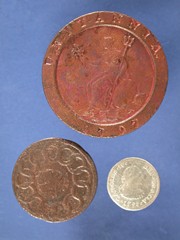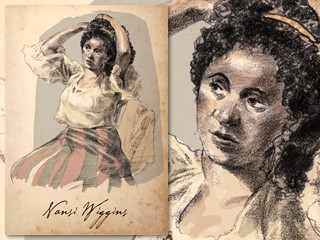British rule of Florida lasted only twenty years, until the colony was returned to Spain in exchange for Gibraltar by the Anglo-Spanish treaty of 1783.
Many of the British residents left for the Bahamas, some went to England, and many elected to remain in St. Augustine.
Although a number of the St. Augustinians who had left in 1763 returned from Cuba when the Spanish regained Florida, more than half of St. Augustine’s population during the second Spanish colonial occupation (1784-1821) was comprised of English, Minorcan, and newly-American families.
The rest of the population came from a variety of European, Spanish-American, African and American Indian backgrounds.
Artifacts

People
Nansi Wiggins

The story of Nansi Wiggins and her family spans the British, Second Spanish and American periods of Florida, and illustrates diversity, fluidity and unpredictability of life during those times. Nansi, also known as Ana Gallum, came to America from Senegal as a slave. She was purchased by an English planter, Job Wiggins, who had a plantation near Rollestown, Florida. Sometime around 1778, Job freed Nansi and married her in a Protestant ceremony.
They had six children before Job died in 1797, and he left the plantation and the charge of the children to Nansi. She managed 1,400 acres of land, a hundred head of cattle and fourteen slaves, and was frequently in St. Augustine selling horses and slaves. Two years after Job died, Nansi was assaulted by St. Augustinian Pedro Casaly when he came to get a horse from her plantation. Casaly was drowned on his way back to St. Augustine, but Nansi bore another son as a result. Nansi and Job’s oldest son, Benjamin, became a skilled translator of Indian languages, and spent a great deal of time among the Seminole. He married the daughter of a prominent free mulatto, and was a successful planter and cattle trader, owning a plantation about 3 miles from St. Augustine.
Nansi and Job’s daughters also made advantageous matches. Beatríz María lived her adult life as the common law wife of Don Carlos Clark, a white officer who was Lieutenant of the Urban and Provincial Militias of Florida during the second Spanish period. His brother, Jorge, was a judge, surveyor and deputy governor of the Fernandina region, whose domestic partner and consort was a black (but enslaved) woman. Don Carlos and Beatríz lived in Fernandina, and had six “quadroon” children between 1799 and 1812. Two of Beatríz María’s sisters, Juana and Jennie, also moved to Fernandina and both came to own property there.
In 1811, their mother Nansi and her 12 year old son also moved to Fernandina, to join her daughters and grandchildren. She purchased three lots in the town. Ten years later, Florida became an United States territory, and part of the “Cotton South”. Although many black and mixed race families left Florida for Cuba, others, including some of Nansi’s descendants, remained to experience the institutionalization of the two-caste racial system that was ushered in by the planters.